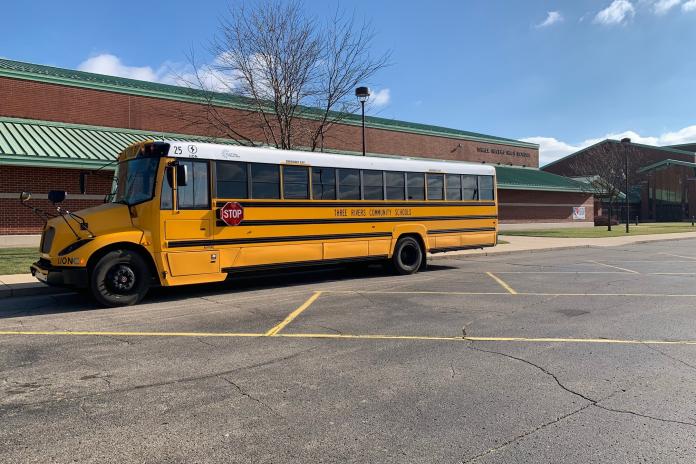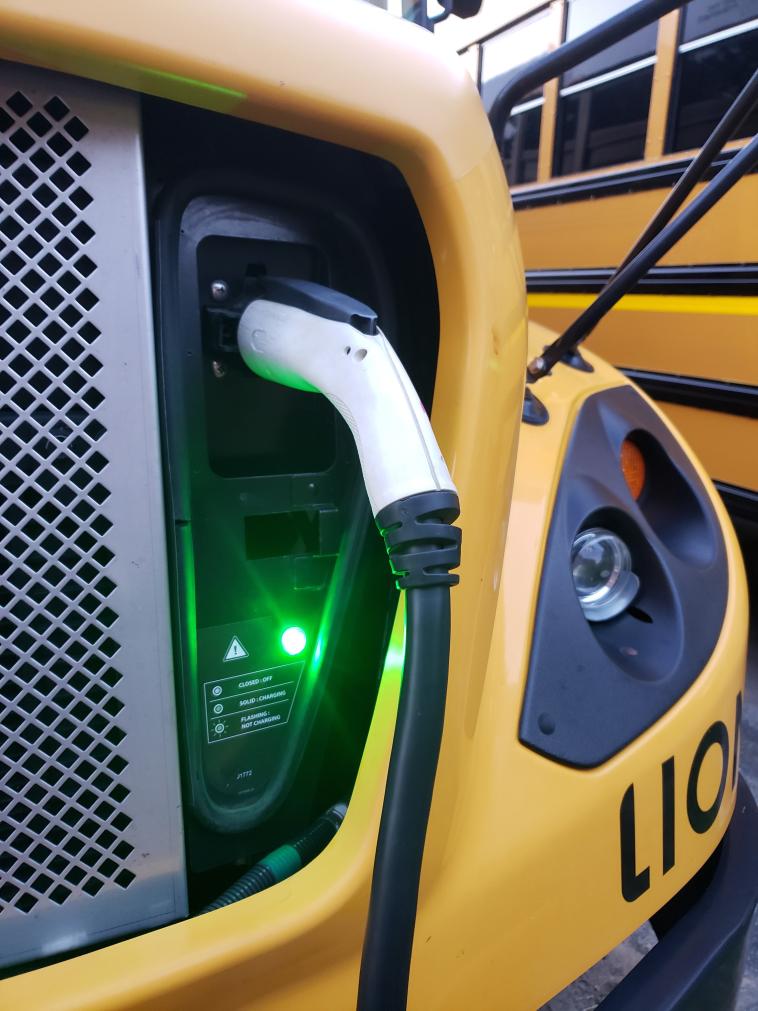Successfully Operating Electric School Buses in Cold Weather in Three Rivers, Michigan
Electric school buses are successfully operating in all manner of weather and climates – such as Three Rivers, Michigan.

In collaboration with partners and communities, WRI’s Electric School Bus Initiative aims to build unstoppable momentum toward an equitable transition of the U.S. school bus fleet to electric, bringing health, climate and economic benefits to children and families across the country and normalizing electric mobility for an entire generation. The Electric School Bus Series shows how superintendents and fleet managers across the United States have pursued school bus electrification in their own communities. This edition covers Three Rivers Community Schools in Michigan, which over the past three years has demonstrated how electric school buses can be successfully deployed in a cold weather climate.
This article is based off an interview with Kenni Jean Schrader, Transportation Director for Three Rivers Community Schools.
The state of Michigan boasts one of the nation's largest electric school bus (ESB) fleets with a total of 152 vehicles committed — the 8th largest of any state — despite operating in temperatures that on average can dip below zero during winter months. In conditions where electric vehicles might be expected to struggle, some school districts in Michigan are showing how ESBs can match or even exceed the performance of their diesel counterparts.
School districts across Michigan are expected to procure many more electric buses, due to the success of early ESB adopters and the recent announcement of $125 million in state funding to support transitioning away from diesel school buses. Among the first districts to operate ESBs in the state was Three Rivers Community Schools. The idea to explore ESB procurement first came to Transportation Director Kenni Jean Schrader in 2016. Intrigued by the buses' potential to boost district-wide sustainability efforts, Schrader began having conversations with stakeholders to determine if ESBs would be right for her district and community. According to Schrader, the decision to pursue ESBs came after she and the district’s facility manager, Brian Leonard, realized that Three Rivers had the unique opportunity to become a “game changer” in the future of sustainable pupil transportation.
Three Rivers Community Schools, alongside six other Michigan school districts — Zeeland Public Schools, Oxford Community Schools, Ann Arbor Public Schools, Gaylord Community Schools, Roseville Community Schools and Kalamazoo Public Schools — decided to see if they could make the idea of ESBs in Michigan a reality. These early adopters pursued funding and financing independently and collaborated to share information and insights about their experiences. Three Rivers received funding for its ESBs through the Volkswagen Diesel Emissions Environmental Mitigation Trust. This grant covered Three Rivers’ purchase of two Type C ESBs, manufactured by Lion Electric, as well as the associated charging equipment. The district was left with $20,000 of out-of-pocket expenses, which went towards installing Level 2 chargers, making infrastructure upgrades at its transportation facility and running new electrical lines to the transformer.
Motivation & Co-benefits
Situated in western Michigan above the I-90 Corridor, where temperatures can reach as low as 20° below zero Fahrenheit (F), Three Rivers Community Schools transports around 1,500 students during the school year. The bus fleet makes its rounds twice a day through both rural and town roads with an average route length of 50 miles. With this in mind, Schrader wanted to make sure that her new ESBs were not only good for the planet but also dependable in all kinds of weather and road conditions. Three years after its initial deployment, Schrader happily reports that the buses have driven exceptionally and, in fact, often outperform their diesel counterparts in cold weather. Specifically, Three Rivers has found that ESBs’ overall heavier weight and the fact that their weight is centered between the axles (as opposed to more front-heavy diesel buses) have made ESBs less likely to fishtail in snowy conditions.
Three years after its initial deployment, Schrader happily reports that the buses have driven exceptionally and, in fact, often outperform their diesel counterparts in cold weather.
The district has also discovered that ESBs start more reliably and reach a comfortable cabin temperature faster than diesel buses on cold mornings. This is due in part to the five-gallon auxiliary diesel heaters that the district installed in its ESBs to keep the battery of the vehicle warm during the coldest months of the year. According to the U.S. Environmental Protection Agency, ESB batteries operate most efficiently around 70°F, making temperature regulation a critical consideration. While ESBs already have thermal management systems (TMSs) that maintain battery temperature using energy from the bus battery, supporting the TMS with a diesel heater can preserve an ESB’s range during particularly cold conditions.
However, these diesel heaters do rely on fossil fuels, offsetting some of the emissions reductions that ESBs provide. It’s important to note that the two small-tank heaters that Three Rivers installed combine to burn only about 52 gallons of diesel during the coldest month of the year and often are not in use 10 of the 12 months of a year. The rate of diesel consumption by an auxiliary heater on an electric bus is significantly less than that of a diesel-powered school bus which, on average, only gets around 6 miles per gallon. Not all districts operating ESBs in cold conditions opt to use auxiliary diesel heaters; for example, Salt Lake City School District makes up for reductions in range with mid-day charging between morning and afternoon routes, enabling its buses to complete all their routes without using an auxiliary heater even on the coldest days.
The success of the Three Rivers’ ESBs in Michigan’s cold weather has also benefited the district financially. Unlike the metal undercarriage of the diesel buses, the Lion ESBs used by Three Rivers boast a rust-resistant fiberglass undercarriage. This is important to Three Rivers as rusting caused by road salt has been an issue for the district and a damaged frame that needs to be replaced can cost $8,000-$9,000 per bus in maintenance expenses.
According to Schrader, this is not the only time ESBs have saved Three Rivers money. A route run by the district in the summer of 2022 reportedly cost $0.13 in electricity costs each day with an electric bus as opposed to the estimated $24 daily fuel cost of running that same route with a diesel bus that summer. The Three Rivers transportation department also shared that the district has saved approximately $44,000 in fuel costs and $45,000 in maintenance and repair costs since the buses were deployed on regular routes following the reopening of schools after the COVID-19 pandemic. These operational savings have been returned to the district's General Fund and are being used to purchase instructional materials for students. Beyond financial savings, the buses are improving the air quality in Three Rivers as well, removing approximately 81.5 metric tons of greenhouse gases since their initial deployment. In addition to the environmental benefits, the improvement in air quality in Three Rivers has a tangible impact on the health of the students who ride the buses, since diesel exhaust pollution is a known carcinogen and has been linked to the impediment of the physical and cognitive development of children.
A route run by the district in the summer of 2022 reportedly cost $0.13 in electricity costs each day with an electric bus as opposed to the estimated $24 daily fuel cost of running that same route with a diesel bus that summer.
Greatest Challenges
While having a largely positive experience with ESBs, Three Rivers has encountered some setbacks that required the district to troubleshoot solutions. Generally, Schrader’s department has found its manufacturers to be willing to help over the phone to directly repair the product, or to send replacement parts. However, there have been times when Three Rivers has been left to solve issues on its own. For example, the vehicle charger handles froze when left connected to the buses overnight. The California-based charger manufacturer — ClipperCreek, now part of Enphase Energy — tried to help district staff over the phone but could not offer in-person service in Michigan. Fortunately, district maintenance was able to find a solution to prevent the charger handles from freezing in the ports. With the experiences of Three Rivers in mind, school transportation providers looking to operate ESBs in cold climates may want to consider talking to manufacturers about how moisture and weather conditions can affect their outdoor charger connections.

Thanks to conscious efforts by Three Rivers’ leadership to promote the ESBs in neighborhoods throughout the community, this pilot project has been widely supported. The biggest issue with the ESBs to date, according to Schrader, has been a handful of early complaints from parents that the comparatively quieter ESBs were causing students to miss the bus, as they no longer could hear them driving up the street. However, families have become more accustomed to the ESBs and have learned to listen for the recorded sound the bus plays when driving at a slow speed or stopping. Now Schrader jokes that her students never miss their bus because they mistake it for an ice cream truck.
Advice for Other Districts
Communicating early and often has been the primary strategy for Three Rivers in dealing with external partners. Schrader attributes much of her fleet's success to conversations she and her colleagues had with the district’s utility company, communities within the Three Rivers school district, peer school districts, ESB manufacturers, state vehicle inspectors and her state’s pupil transportation association.
Three Rivers’ utility, Indiana Michigan Power Co. (an affiliate of American Electric Power), was a particularly important collaborator throughout the process. By establishing a collaborative working relationship with its utility, Three Rivers was able to negotiate a tariff that enabled charging its buses during off-peak hours for a reduced rate. In addition to this, the district invited engineers from the utility company for an on-site walk through prior to procurement and held regular meetings with utility representatives for two years to ensure that both parties were on the same page. Schrader also recommends “doing your homework” when it comes to dealing with manufacturers and ESB dealers. Make sure you have a sense of what is right for your district and get quotes from a variety of vendors to ensure you’re getting the best price and equipment for your fleet’s needs.
Internally, a successful deployment requires buy-in from your own district. Three Rivers found it helpful to allow the bus drivers who were most excited about ESBs to drive them first. According to Schrader, when other drivers noticed that the ESB drivers were having a positive experience with the vehicles, they became more willing to experiment with the technology. Three Rivers also consistently looked for opportunities to keep the community engaged with ESBs, including allowing shop classes to learn from the buses and using them to provide Wi-Fi access to rural areas for remote learning during pandemic-related school closures.
Future Plans
With plans to break ground on a new transportation facility in the summer of 2023, Three Rivers is looking to electrify more of its 26-bus fleet. The new facility will include four ESB chargers as well as the appropriate infrastructure to support eight additional chargers. Schrader recognizes that it may take time to get funding for these new buses, but with the help of the strong network of ESB allies her district has built, it seems more than likely that they will get it done.
Want to learn more from the Electric School Bus Series? Explore more stories here.